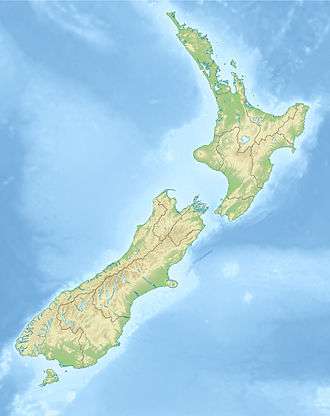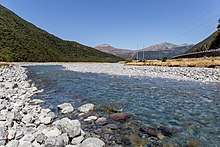Arthur's Pass
Arthur's Pass, previously called Camping Flat then Bealey Flats, and for some time officially Arthurs Pass, is a township in the Southern Alps of the South Island of New Zealand, located in the Selwyn district. It is a popular base for exploring Arthur's Pass National Park.
Arthur's Pass | |
|---|---|
Township | |
 Arthur's Pass Village | |
 Arthur's Pass | |
| Coordinates: 42°56′43.4″S 171°33′56.4″E | |
| Country | New Zealand |
| Region | Canterbury |
| District | Selwyn |
| Founded | 1906 (originally named Bealey Flat) |
| Electorates | Selwyn Te Tai Tonga |
| Area | |
| • Total | 0.6 km2 (0.2 sq mi) |
| Elevation | 739 m (2,425 ft) |
| Population | |
| • Total | 29 |
| Time zone | UTC+12 (NZST) |
| • Summer (DST) | UTC+13 (NZDT) |
| Postcode | 7654 |
| Area code(s) | 03 |
| Local iwi | Ngāi Tahu |
Arthur's Pass township is about 5 kilometres (3.1 mi) south of the mountain pass with the same name. Its elevation is 740 metres (2,430 ft) above sea level surrounded by beech forest. The Bealey River runs through the township. The town is located 153 kilometres (95 mi) from Christchurch a 2-hour drive on State Highway 73.
Naming and history
The township and the pass take their names after Arthur Dudley Dobson (1841–1934, Sir Arthur from 1931). The Chief Surveyor of Canterbury Province, Thomas Cass, had tasked Arthur Dobson to find out if there was an available pass out of the Waimakariri watershed into valleys running to the West Coast. In 1864 Arthur's brother Edward Henry Dobson joined him and accompanied him over the watershed into the valley of the Otira River. A West Coast Māori chief, Tarapuhi, told Arthur of a pass that Māori hunting-parties occasionally used. When Arthur returned to Christchurch, he sketched the country he had traversed and included it in a report to Cass. Arthur Dobson did not name the pass, which he found very steep on the western side.[1] Dobson gave the name "Camping Flat" to the site that became the township.
When the West Coast gold rush began in 1864, a committee of businessmen offered a £200 prize for anyone who would find a better or more suitable pass from Canterbury over the Southern Alps to West Canterbury (the West Coast). At the same time George Dobson, (another brother), was sent to examine every available pass between the watershed of the Taramakau, Waimakariri, and the Hurunui. After examining passes at the head of every valley he reported that "Arthur's" pass was by far the most suitable for the direct crossing.[2]
The township, at the time named Bealey Flats after the second Superintendent of Canterbury, Samuel Bealey, was originally built as a construction village for the building of the Otira Tunnel, which started on 14 January 1908.[3] The railway from Christchurch reached Arthur's Pass township in 1914, the Westland section having advanced to Otira. Construction of the tunnel was very slow; it finally finished in 1923, and its opening marked by the British and Intercolonial Exhibition.[4] The TranzAlpine passenger rail service passes through Arthur's Pass and the Otira Tunnel as part of its 223 kilometres (139 mi) journey from Christchurch to Greymouth. The trip is considered one of the world's great train journeys due to its scenery and views.
A power station was built below the Devil's Punchbowl Falls to provide electricity for the tunnel construction and for the village itself.
In 1929 the Arthur's Pass National Park was established, New Zealand's third national park.[5][6]
The Geographic Board had a policy of omitting apostrophes in place names, and the name was officially changed to "Arthurs Pass". This caused an upset with the local population, and the Minister of Lands reinstated the old version with the apostrophe. On 16 September 1975 the New Zealand Post Office also adopted the spelling with the apostrophe.[5]
Climate
Arthur's Pass Village lies in a valley about 750 metres above sea level and is about 4 km south of Arthur's Pass (920 m). Arthur's Pass Village falls under the Köppen-Geiger climate classification of Cfb (Oceanic). Being situated at a relatively high altitude surrounded by peaks well over 1500 m, this contributes to chilly winter mornings, sometimes reaching below −10°C. This geographical position allows warmer air to pool in the valley during the summer. Summer days often reach a pleasant 20°C, reaching 25°C once every few years. On average, February is the warmest month with an average of 13.4°C, and July is the coldest with an average of 3°C. Snowfall is fairly common throughout winter, especially in the mountains above the village.
| Climate data for Arthur's Pass, 750 m | |||||||||||||
|---|---|---|---|---|---|---|---|---|---|---|---|---|---|
| Month | Jan | Feb | Mar | Apr | May | Jun | Jul | Aug | Sep | Oct | Nov | Dec | Year |
| Record high °C (°F) | 27.1 (80.8) |
29.8 (85.6) |
26.4 (79.5) |
22.5 (72.5) |
20.7 (69.3) |
15.3 (59.5) |
15.3 (59.5) |
16.2 (61.2) |
19.4 (66.9) |
21.4 (70.5) |
24.2 (75.6) |
27.1 (80.8) |
29.8 (85.6) |
| Average high °C (°F) | 18.3 (64.9) |
18.4 (65.1) |
16.5 (61.7) |
13.7 (56.7) |
10.5 (50.9) |
7.8 (46.0) |
7 (45) |
8 (46) |
10.5 (50.9) |
12.6 (54.7) |
14.6 (58.3) |
16.7 (62.1) |
12.9 (55.2) |
| Daily mean °C (°F) | 13.4 (56.1) |
13.4 (56.1) |
11.8 (53.2) |
9.2 (48.6) |
6.2 (43.2) |
3.7 (38.7) |
3 (37) |
4 (39) |
6.2 (43.2) |
8.1 (46.6) |
9.9 (49.8) |
12 (54) |
8.4 (47.1) |
| Average low °C (°F) | 8.5 (47.3) |
8.5 (47.3) |
7.2 (45.0) |
4.7 (40.5) |
1.9 (35.4) |
−0.3 (31.5) |
−1 (30) |
0 (32) |
1.9 (35.4) |
3.7 (38.7) |
5.3 (41.5) |
7.3 (45.1) |
4 (39) |
| Record low °C (°F) | −0.9 (30.4) |
−2.9 (26.8) |
−4.4 (24.1) |
−7 (19) |
−10 (14) |
−12 (10) |
−12 (10) |
−10 (14) |
−7.5 (18.5) |
−6.4 (20.5) |
−4.7 (23.5) |
−2.5 (27.5) |
−12 (10) |
| Average rainfall mm (inches) | 348 (13.7) |
212 (8.3) |
311 (12.2) |
319 (12.6) |
381 (15.0) |
297 (11.7) |
285 (11.2) |
305 (12.0) |
362 (14.3) |
403 (15.9) |
402 (15.8) |
359 (14.1) |
3,984 (156.9) |
| Source: Climate-data.org[7] | |||||||||||||
Facilities and attractions
The township has a DOC ranger station, which also accommodates a visitor information and an informative display room. Visitor accommodation is provided, from camp ground up to hotel standard. The township provides a general store, a petrol station, tea rooms and restaurants.
There are also several good walks from here, including the Devil's Punchbowl Falls,[8] Bealey Valley[9] and Avalanche Peak.[10] The mischievous kea (New Zealand mountain parrot) can be found here.
The club skifield Temple Basin is nearby and is a popular attraction through winter.
The town can be reached by The Tranz Alpine Express train on the famous Midland Line. State Highway 73 also passes through the town.
- Photo gallery
 Memorial at the mountain pass
Memorial at the mountain pass Devil's Punchbowl Fall
Devil's Punchbowl Fall Bealey River at Arthur's Pass
Bealey River at Arthur's Pass Arthur's Pass train station
Arthur's Pass train station Wobbly Kea Cafe
Wobbly Kea Cafe Two coal trains passing at Arthur's Pass station, June 2015
Two coal trains passing at Arthur's Pass station, June 2015
References
- McLintock, A. H. (22 April 2009). "DOBSON BROTHERS". Te Ara – the Encyclopedia of New Zealand. Retrieved 30 September 2011.
-
McLintock, A. H. (22 April 2009). "Dobson Brothers". Te Ara – the Encyclopedia of New Zealand. Retrieved 21 November 2019.
At the same time George Dobson was sent to examine every available pass between the watershed of the Taramakau, Waimakariri, and the Hurunui, and after examining passes at the head of every valley he reported that 'Arthur's' pass was by far the most suitable for the direct crossing.
- http://paperspast.natlib.govt.nz/cgi-bin/paperspast?a=d&d=TC19080115.2.10 Colonist, Volume L, Issue 12140, 15 January 1908, Page 2; accessed 1 January 2010
- "The British and Intercolonial Exhibition, Hokitika, Westland, New Zealand, December 15th, 1923 to February 2nd, 1924 : to celebrate the opening of the East and West Coast railway, to commemorate the diamond jubilee of the Province of Westland, 1864–1924. – Version details – Trove". Retrieved 16 June 2020.
- http://www.nzhistory.net.nz/timeline&new_date=12/3 Article on Arthur's Pass on NZ History website; accessed 1 January 2010
- Reed, A. W. (2010). Peter Dowling (ed.). Place Names of New Zealand. Rosedale, North Shore: Raupo. p. 31. ISBN 978-0-14-320410-7.
- "Climate-data.org – Climate Data for Cities Worldwide". openstreetmap.org. Retrieved 17 December 2019.
- Short walking tracks in Arthur's Pass, Department of Conservation.
- Half-day walks in Arthur's Pass, Department of Conservation.
- Day walks in Arthur's Pass, Department of Conservation.
External links
| Wikimedia Commons has media related to Arthur's Pass. |